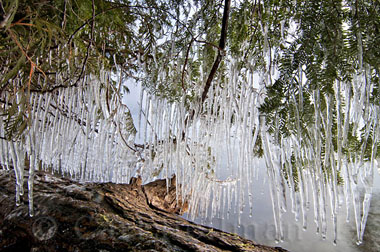As winter settles in around the Adirondacks, cold Canadian air slips south and gives a good chill to the region. Ice forms on puddles, ponds, streams, and finally the larger lakes in the region. Both Lake Champlain and Lake George are the last to freeze over, with the main body of Lake Champlain, and sometimes Lake George, often remaining open throughout the winter months.
Open water and zero (F) or below air temperatures create unique photo opportunities with a combination of ice, mist, snow, and light. The extremes in air temperature cause mist to form, and sometimes freeze on all the branches along the shore. Wind blown lakes in these temperatures creates icicles and a buildup of ice all along the shoreline. Once the lake water temperature is cold enough, ice crystals form, as well as ice pans that blow into bays and gently bob up and down on the waves rolling in. As the surrounding air becomes saturated with enough moisture, fog and clouds may form along the length of the open water in the lake.
The general rules for exposure apply. When working in Aperture or Shutter Priority, if the scene is mostly white, add some overexposure compensation to brighten up the snow in the photos.
Source: Cold Air and Open Water – The Adirondack Viewfinder: Adirondack Photography By Carl Heilman

Leave a Reply